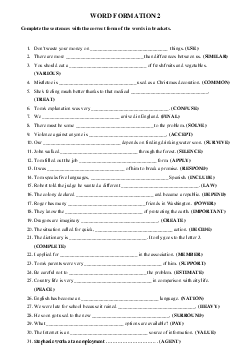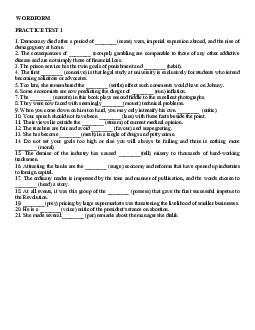





Preview text:
1 CAE Multiple Choice Cloze
For questions 1- 8, read the text below and decide which answer (A, B, C or D) best fits each gap. EXAM DESCRIPTION Scotland
People come to this small northern country for many reasons, lured, perhaps, by the promise of
spectacular (1) ... ?, friendly natives, and a vibrant arts scene. Some are searching for their family
(2) ... ? or others just want to get away from it all and, digging (3) ... ? old memories from their
English Lit class of gallant heroes engaging in larger-than-life struggles, their (4) ... ? wander to
faraway lands, to somehow familiar yet different destinations. Why not go to Scotland? But what
kind of country are they coming to and what should they expect once they get there? Scotland
(5) ... ? of an area of 30, 418 square miles - so it's a fairly compact and "doable" country - with a
population of about five million people - not too small, not too big. It is one of three countries that
form the political (6) ... ? called Great Britain, the other two being, of course, England and Wales,
which, along with their fourth partner, Northern Ireland, becomes the United Kingdom. Scotland is
bordered on three sides by water and on its fourth by England, which has had both its advantages
and disadvantages. Geographically speaking, the country can be divided into three broad areas,
the Southern Uplands, the Central Lowlands, and the Highlands. Although the rugged Highlands (7)
... ? about two-thirds of the land area, the (8) ... ? majority of the population lives in the Central
Belt between Glasgow, Scotland's largest city, and Edinburgh, Scotland's capital. 1. A) scene B) scenery C) view D) panorama 2. A) roots B) race C) basis D) source 3. A) off B) down C) on D) up 4. A) head B) brains C) spirits D) minds 5. A) consists B) includes C) embraces D) comprises 6. A) entirety B) entitle C) entry D) entity 7. A) take out B) take in C) take up D) take off 8. A) expansive B) vast C) expanding D) spacious TIPS 1
Which of the given words collocates with 'spectacular'? 2
This is a fixed phrase which means 'the feelings or connections that you have with a place
because your family came from there'. 3
You need to create a phrasal verb here. 4
What word should be used with 'wander' here? 5
Which of the given words collocates with 'of'? 6
Which of the following words fits the context in this gap? 7
You need to create a phrasal verb that means 'to fill or use an amount of space or time'. 8
Which of the given words collocates with 'majority'?ANSWERS SCENERY
COLLOCATION SPECTACULAR SCENERY
(SCENERY => UNCOUNTABLE) The natural features of a particular part of a country that you can
see, such as mountains, forests, deserts etc:
Reunion Island is a wildly tropical Island with spectacular scenery. show hide answer 2 ROOTS COLLOCATION FAMILY ROOTS
Your relation to a place because you were born there, or your family used to live there:
Why not try to trace family roots when you travel? show hide answer 3 UP PHRASAL VERB DIG UP
To find hidden or forgotten information by careful searching:
They tried to dig up some dirt on their political enemies. show hide answer 4 MINDS COLLOCATION MINDS WANDER
If your mind, thoughts etc wander, you no longer pay attention to something, especially because you are bored or worried:
Does your mind wander while performing daily tasks? show hide answer 5 CONSISTS VERB + PREPOSITION CONSIST OF
To be formed from the things or people mentioned:
The house consists of six rooms. show hide answer 6 ENTITY COLLOCATION POLITICAL ENTITY
A unit with political responsibilities:
A new autonomous political entity will be created to replace the existing Autonomous Region of Muslim Mindanao. show hide answer 7 TAKE UP PHRASAL VERB TAKE UP
To fill or use an amount of space or time:
How much space will the wardrobe take up? show hide answer 8 VAST COLLOCATION VAST MAJORITY Almost all of a group:
The vast majority of people can read and write. 2 CAE Multiple Choice Cloze
For questions 1- 8, read the text below and decide which answer (A, B, C or D) best fits each gap. EXAM DESCRIPTION The Microscope
An important invention in the development of science and medicine was the microscope. It was (1)
... ? the principle that light could be “(2) ... ?” or bent, by a glass lens. It was soon discovered that
tiny objects could be magnified (3) ... ? size when viewed through a glass lens that had been
ground and polished in a specific (4) ... ?. Although the principle was known to the Chinese as early
as 1000 A.D, it was not until the 13th and 14th centuries in Europe (5) ... ? it was put to practical
use in the form of eyeglasses. In Europe the first microscope was invented by brothers Zacharias
and Hans Janssen, two Dutch eyeglass-makers, around 1590. They built a “compound” microscope,
so called because of its two lenses. The most significant development and use of the microscope
during this period, however, belongs to another Dutch optician, Antonie van Leeuwenhoek (1632-
1723). Born in Delft, Holland, he became skilled at (6) ... ? very sharp and accurate magnifying
lenses. Some of his single-lens microscopes were able to magnify up the three hundred times (7) ...
? size, and around 1660 he began serious study using these instruments. He was the first to
discover bacteria and other microscopic organisms, calling these tiny creatures “animalcules”. (8) ...
? to this discovery, very small creatures such as fleas and maggots were thought to “spontaneously
generate” from a single source, such as rotting meat in the case of maggots. 1. A) based upon B) based by C) based in D) based at 2. A) refracted B) retracted C) retorted D) retraced 3. A) by B) on C) in D) with 4. A) procedure B) manner C) fashion D) character 5. A) when B) than C) then D) that 6. A) granting B) grinding C) scraping D) rubbing 7. A) present B) substantial C) actual D) current 8. A) According B) Due C) Owing D) Prior TIPS 1
Which of the following phrases should be used here? 2
The word you should use means 'to make light change direction when it goes through at an angle'. 3
Which of the given prepositions is to be used in this gap? 4
Which of the given words is correct here? 5
The word you are looking for means 'the way in which something is done or happens'. 6
'It wasn't until' must be followed by one of the given words. Do you know the rules? 7
Which of the given words strongly collocates with 'use'? 8
Do you know which word should be used in this gap? ANSWERS show hide answer 1 BASED UPON VERB + PREPOSITION BASE UPON
To use something as the thing from which something else is developed:
An opinion should be based upon facts, not guesses. show hide answer 2 REFRACTED VERB REFRACT
If glass or water refracts light, the light changes direction when it passes through the glass or water:
Light is refracted when passed through a prism. show hide answer 3 IN PHRASE IN SIZE
How big or small something is:
They didn't have the boots in my size. show hide answer 4 MANNER IDIOM IN A MANNER
The way in which something is done or happens:
She greeted me in a friendly manner. show hide answer 5 THAT
IDIOM IT WAS NOT UNTIL + PAST SIMPLE + THAT
Used to emphasize that something does not happen before a certain point in time or before something else has happened:
It was not until midnight that I finally decided to go home. show hide answer 6 GRINDING VERB GRIND
To make something smooth or sharp by rubbing it on a hard surface or by using a machine:
I need a special stone for grinding knives. show hide answer 7 ACTUAL ADJECTIVE ACTUAL
Used to emphasize that something is real or exact:
The actual cost was higher than we expected. show hide answer 8 PRIOR PHRASE PRIOR TO Before something:
All the arrangements should be completed prior to your departure. englishrevealed




